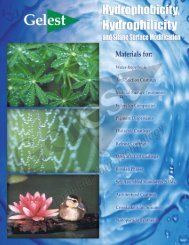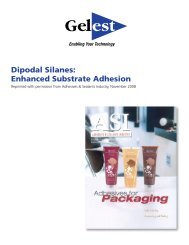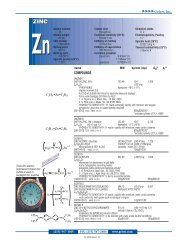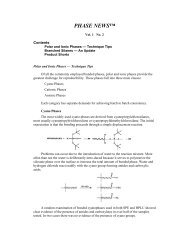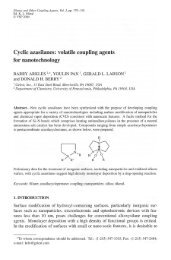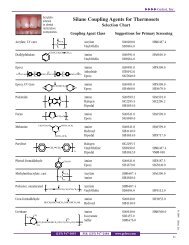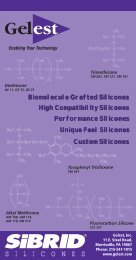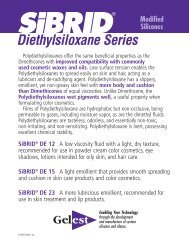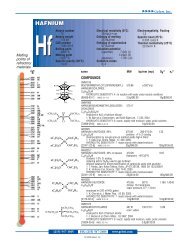Silicon Innovations for Cosmetics - Gelest Inc.
Silicon Innovations for Cosmetics - Gelest Inc.
Silicon Innovations for Cosmetics - Gelest Inc.
Create successful ePaper yourself
Turn your PDF publications into a flip-book with our unique Google optimized e-Paper software.
New and innovative silicon<br />
technologies will continue<br />
to deliver per<strong>for</strong>mance and<br />
aesthetic advantages <strong>for</strong><br />
evolving cosmetic industry<br />
requirements. <strong>Gelest</strong> PCS<br />
applies fundamental science<br />
and applied development in<br />
silicon chemistry and polymer<br />
technology to assist cosmetic<br />
chemists in meeting these<br />
demands. The results of these<br />
ef<strong>for</strong>ts have led to a commercial<br />
product line of truly unique<br />
cosmetic raw materials as well<br />
as custom materials developed<br />
jointly with individual customers.<br />
<strong>Gelest</strong> PCS combines R&D,<br />
pilot plant operations and<br />
commercial production at its<br />
state of the art Morrisville, PA<br />
facility to rapidly commercialize<br />
new innovative materials and<br />
to maintain a solid inventory<br />
of commercial products. With<br />
a technical staff experienced<br />
in silicon chemistry, silicone<br />
polymers and application<br />
technology <strong>Gelest</strong> PCS is well<br />
positioned to be your preferred<br />
partner <strong>for</strong> <strong>Silicon</strong> <strong>Innovations</strong>.<br />
silicon innovations<br />
<strong>Silicon</strong> <strong>Innovations</strong> <strong>for</strong> <strong>Cosmetics</strong>
Diethicone<br />
DE-12, DE-15, DE-23<br />
Although polydimethylsiloxanes (Dimethicones)<br />
and their many organic derivatives have been used<br />
extensively in the cosmetic industry, no polysiloxanes<br />
without methyl substitution have been developed <strong>for</strong><br />
personal care. The Dimethicones are characterized<br />
by their ability to improve slip, increase lubricity,<br />
reduce tack, and impart water repellency in all types<br />
of cosmetic <strong>for</strong>mulations. The insolubility of many<br />
surfactants, emollient oils, and waxes in Dimethicone<br />
causes <strong>for</strong>mulation difficulties and restricts the amount<br />
of Dimethicone that can be incorporated into a<br />
product.<br />
Polydiethylsiloxanes (Diethicones) are the first series<br />
of hybrid silicone polymers with other than methyl<br />
substitution. Analogous in structure to Dimethicones,<br />
the flexible polymer backbone of Diethicones allows<br />
the manufacture of a wide range of fluid viscosities.<br />
Dimethicone’s beneficial properties of excellent<br />
spreading, gas permeability, and waterproofness are<br />
maintained due to the similarity of physical properties.<br />
Low surface tension enables the Diethicones to<br />
spread easily on skin and hair, acting as lubricants<br />
and detackifying agents. Tactile properties include a<br />
“dry feel” with increased “cushion”. Most significantly,<br />
Diethicones have a much broader organic<br />
compatibility, allowing <strong>for</strong>mulation with common<br />
cosmetic raw materials, including many hydrocarbons,<br />
esters, waxes, and surfactants. Unlike Dimethicones,<br />
Diethicones wet pigments well, a useful property when<br />
<strong>for</strong>mulating color cosmetics and suncreens containing<br />
pigments.<br />
Trisiloxanes<br />
The alkyl trisiloxanes are light, dry, emollient oils with<br />
good organic compatibility, even greater than that<br />
of phenyl trimethicone. They are used to enhance<br />
slip and reduce tack in hair care, skin care and color<br />
cosmetics. Organic and inorganic pigments can be<br />
easily wetted and dispersed in the alkyl trisiloxanes <strong>for</strong><br />
use in foundations, eyeshadows, blushes and lip color.<br />
TM-081 Caprylyl Methicone offers an exceptionally<br />
light, dry feel, combined with excellent spreading<br />
properties. TM 081 is an excellent vehicle <strong>for</strong> long<br />
wearing foundations and eyeshadows.<br />
TM-121 Lauryl Methicone is similar to TM 081 with<br />
reduced volatility and increased pigment wetting<br />
properties.<br />
TM-181 Stearyl Methicone is slightly more lubricious<br />
than TM-081 and TM-121 but leaves a smooth<br />
weightless feeling on the skin. TM 181 can be used to<br />
reduce tack and lend a lighter feel to skin treatment<br />
products and liquid foundations.<br />
Alkyl-Arylalkyl <strong>Silicon</strong>es<br />
AM-108 is a C 8<br />
modified silicone that provides a rich,<br />
emollient feel in skin treatment products. AM-108<br />
spreads to <strong>for</strong>m a non-tacky protective layer, leaving<br />
the skin feeling softer with improved flexibility. In<br />
lipsticks, AM-108 softens and smooths the lips and has<br />
good compatibility with other ingredients.<br />
AM-114 is a C 14<br />
modified silicone wax having a<br />
melting point close to that of skin temperature.<br />
<strong>Inc</strong>orporated into creams and lotions, AM-114 <strong>for</strong>ms<br />
a non-tacky protective layer on the skin with a rich<br />
emollient feel. In lipsticks, AM 114 provides excellent<br />
slip with conditioning, softening, and smoothing<br />
properties.<br />
AM-118 is a C 18<br />
modified silicone wax used to provide<br />
structure to powdercream products while maintaining<br />
slip and spreading properties. AM-118 is also used to<br />
gel combinations of silicones and conventional oils.<br />
PM-212 is a viscous, high refractive index C 12<br />
/phenylpropyl modified silicone that gives high luster<br />
and shine to lip products. Films <strong>for</strong>med using PM-212<br />
resist feathering and creeping, allowing the <strong>for</strong>mulation<br />
of emollient lip glosses and lipsticks. PM-212 can also<br />
be used in skin and sun care products to improve skin<br />
adhesion and film <strong>for</strong>ming capability.<br />
Biomolecule <strong>Silicon</strong>e<br />
TM-VE1 is a unique hybrid organo-silicon compound<br />
<strong>for</strong>med by grafting tocopherol to a siloxane backbone.<br />
The tocopheryl substituent adds skin treatment<br />
properties to the siloxane backbone while the<br />
siloxane component improves the slip and skin feel<br />
of the tocopherol. This unique structure enables the<br />
Tocopheryloxypropyl Trisiloxane to act as a solvent <strong>for</strong><br />
a number of mineral and vegetable waxes. TM-VE1 is<br />
recommended <strong>for</strong> use in skin care and lip products to<br />
provide softening, emolliency and moisturization.<br />
Fluorocarbon <strong>Silicon</strong>e<br />
FCS-331 is a highly lubricious gel consisting<br />
of submicron particles of a tetrafluoroethylene/<br />
hexafluoropropylene copolymer dispersed in a<br />
fluorinated dimethyl fluid. The gel has the unusual<br />
property of increasing slip as higher amounts of shear<br />
<strong>for</strong>ce are applied.<br />
The fluorinated dimethyl fluid, the base <strong>for</strong> FCS-<br />
331, is insoluble in other polydimethylsiloxane fluids<br />
and common organic oils, but can be dispersed in<br />
cyclic siloxanes <strong>for</strong> incorporation into emulsions and<br />
anhydrous systems. Skin care products containing FCS-<br />
331 deposit a persistent soft, pleasant-feeling film that is<br />
resistant to washing off.<br />
<strong>Inc</strong>orporated into color cosmetics,<br />
FCS-331 not only imparts excellent slip and spreading<br />
characteristics, but improves wear by resisting<br />
wetting by sebum. FCS-331 can be used alone or<br />
in combination with oily binders in pressed powders<br />
to <strong>for</strong>mulate creaseproof eyeshadows and powder<br />
foundations that are resistant to oil breakthrough.<br />
In liquid foundations, FCS-331 aids spreading and<br />
blending, improves residual feel, and extends wear.<br />
innovative silicon solutions
<strong>for</strong>mulations<br />
Lipstick with TM-VE1 /GJH2-24-3<br />
Unlike many silicones and silicone derivatives, TM-VE1 is easily incorporated<br />
into lip products due to its solubility in a range of polar compounds,<br />
including castor oil. Benefits of TM-VE1 in lip products are lip<br />
conditioning, lip softening, and protection against the drying effects of<br />
the environment.<br />
Ingredient (Supplier) inci name %<br />
Crystal O, (Caschem) Castor Oil 13.45<br />
Schercemol TISC, (Noveon) Triisostearyl Citrate 30.00<br />
Eutanol G Octyldocecanol 5.00<br />
TM-VE1, (<strong>Gelest</strong>PCS) Tocopheryloxypropyl Trisiloxane* 2.50<br />
Ceraphyl ODS Octyldodecyl Stearate 7.50<br />
Methylparaben 0.20<br />
Propylparaben 0.10<br />
Candelilla 6.00<br />
Carnauba 1.00<br />
Microwax SP 19, (Strahl & Pitsch) Microcrystalline Wax 3.00<br />
Ozokerite 170D, (Ross Wax) Ozokerite 2.00<br />
Color Grind<br />
Crystal O, (Caschem) 10.00<br />
A-1206, (Color Techniques) Iron Oxides 6.50<br />
AHP-200, (Kemira) Titanium Dioxide 2.50<br />
c39-4433, (Sun Chemical) Blue 1 Lake 0.10<br />
c19-7711, (Sun Chemical) Red 7 Lake 0.75<br />
c19-7712, (Sun Chemical) Red 6 Lake 1.35<br />
Timiron Splendid Red, Mica, Titanium Dioxide, Silica 8.00<br />
(EMD Chemicals, Rona div.)<br />
Ascorbyl Palmitate, (DSM) 0.05<br />
*INCI Name application pending 100.00<br />
Super Shine Lipgloss w/PM-212 & AM-118 /GJH2-48-1<br />
PM-212 provides high shine and com<strong>for</strong>table wear. AM-118 gels the<br />
oil to suspend the pigments.<br />
Ingredient (Supplier) inci Name %<br />
Schercemol TISC, (Noveon) Triisostearyl Citrate 74.19<br />
PM-212, (<strong>Gelest</strong>PCS) Laurylphenylpropyl Methicone 20.00<br />
AM-118, (<strong>Gelest</strong>PCS) Stearyl Methicone 5.00<br />
Methylparaben 0.20<br />
Propylparaben 0.10<br />
AS Timiron Spendid Red, Mica, TiO 2<br />
, SiO 2<br />
(Rona div. EMD Chemicals) treated w/triethoxycaprylylsilane 0.50<br />
40% Red 7 Lake in DE-15 0.01<br />
100.00<br />
Water in <strong>Silicon</strong>e Foundation with DE-12 and AM-118<br />
GJH2-24-3<br />
Ingredient (Supplier) inci name %<br />
Water Phase<br />
Deionized water 48.90<br />
Magnesium Sulfate 0.20<br />
Butylene Glycol 6.00<br />
Methylparaben 0.20<br />
Benzoic Acid 0.10<br />
<strong>Silicon</strong>e Phase<br />
Cyclopentasiloxane 15.00<br />
KF 6028, (Shin-Etsu)<br />
PEG-9 Polydimethylsiloxyethyl<br />
Dimethicone 2.00<br />
DE-12, (<strong>Gelest</strong>PCS) Polydiethylsiloxane 5.00<br />
AM-118, (<strong>Gelest</strong>PCS) Stearyl Methicone 1.00<br />
Rhodasurf L-790, (Rhodia) Laureth-7 0.50<br />
Propylparaben 0.10<br />
Pigment Grind (add to silicone phase after milling)<br />
D 9812/I, (Color Techniques) Titanium Dioxide, Methicone 8.00<br />
D 9131/I, (Color Techniques) Iron Oxides, Methicone 1.20<br />
D 9126/ , (Color Techniques) Iron Oxides, Methicone 0.50<br />
D 9146/I, (Color Techniques) Iron Oxides, Methicone 0.20<br />
D 10707/I, (Color Techniques) Talc, Methicone 4.10<br />
DE-12, (<strong>Gelest</strong>PCS) Polydiethylsiloxane 7.00<br />
100.00<br />
Water in Oil Lotion with TM-181 & AM-118 /GJH1-62-1<br />
TM-181 provides slip and light emolliency to this moisturizing lotion.<br />
AM-118 gels the oil phase to control viscosity.<br />
Ingredient (Supplier) inci Name %<br />
Phase A<br />
Deionized Water 62.15<br />
NaCl Sodium Chloride 1.00<br />
Butylene Glycol 6.00<br />
Methylparaben 0.20<br />
Benzoic Acid 0.20<br />
Phase B<br />
Abil® EM-90, (Degussa) Cetyl PEG/PPG 10/1 Dimethicone 2.00<br />
Abil® WE-09, (Degussa) Polyglyceryl-4 Isostearate,<br />
Cetyl PEG/PPG<br />
10/1 Dimethicone, Hexyl Laurate 0.90<br />
Ceraphyl® ODS, (ISP) Octyldodecyl Stearate 9.70<br />
TM-181, (<strong>Gelest</strong>PCS) Stearyl Methicone 15.80<br />
AM-118, (<strong>Gelest</strong>PCS) Stearyl Methicone 2.00<br />
Propylparaben 0.05<br />
100.00<br />
Diethicone<br />
Alkyl Methicone<br />
Alkyl Methicone<br />
Tocopheryloxypropyl Trisiloxane
<strong>for</strong>mulations<br />
Powdercream Makeup w/ AM-118 & DE-12 /GJH1-70-1<br />
DE-12 has the characteristic light, dry feel of a Dimethicone, yet can act<br />
as the sole solvent <strong>for</strong> the <strong>for</strong>mula waxes. AM-118 is a silicone wax that<br />
provides structure to the product without the tack associated with most<br />
conventional waxes.<br />
Ingredient (Supplier) inci Name %<br />
Phase A<br />
Syncrowax HRC, (Croda) Tribehenin 5.70<br />
AM-118, (<strong>Gelest</strong>PCS) Stearyl Methicone 6.60<br />
DE-12, (<strong>Gelest</strong>PCS) Polydiethylsiloxane 39.69<br />
Emerest 2452, (Cognis) Polyglyceryl-3 Diisostearate 0.70<br />
Methylparaben 0.20<br />
Propylparaben 0.10<br />
BHT 0.01<br />
Phase B<br />
AS 5812 Titanium Dioxide, Titanium Dioxide,<br />
(Color Techniques) Triethoxycaprylylsilane 15.00<br />
AS 5137 Yellow Iron Oxide, Iron Oxides,<br />
(Color Techniques) Triethoxycaprylylsilane 2.80<br />
AS 5126 Red Iron Oxide, Iron Oxides,<br />
(Color Techniques) Triethoxycaprylylsilane 1.20<br />
AS 5146 Black Iron Oxide, Iron Oxides,<br />
(Color Techniques) Triethoxycaprylylsilane 0.25<br />
AS 50707 Talc,<br />
Talc, Triethoxycaprylylsilane<br />
(Color Techniques) 9.75<br />
AS 5061 Sericite, (Color Techniques) Mica, Triethoxycaprylylsilane 12.00<br />
AS 5071 Nylon Nylon-12, Triethoxycaprylylsilane 6.00<br />
100.00<br />
Pressed Powder with FCS-331 /GJH1-71-1<br />
FCS-331 provides exceptional slip, smooth skin feel, and improved wear.<br />
Ingredient (Supplier) inci Name %<br />
Phase A<br />
Talc 10707, (Color Techniques) Talc 56.10<br />
Zinc Stearate 3.00<br />
D-9051, (Color Techniques) Mica, Methicone 20.00<br />
A-8112, (Color Techniques) Titanium Dioxide 8.00<br />
A-1301, (Color Techniques) (Yellow) Iron Oxides 2.00<br />
A-1226, (Color Techniques) (Red) Iron Oxides 1.25<br />
A-1404, (Color Techniques) (Black) Iron Oxides 0.35<br />
Methylparaben 0.20<br />
Propylparaben 0.10<br />
Phase B<br />
Cromollient DP3A, (Croda) di-PPG-3 Myristyl Ether Adipate 4.00<br />
FCS-331, (<strong>Gelest</strong>PCS)<br />
Trifluoropropyl Dimethicone (and)<br />
Hexafluoropropylene/<br />
Tetrafluoroethylene Copolymer 5.00<br />
100.00<br />
Pressed Powder with DE-15 /JHP2-36-1<br />
The Diethicone wets the powder sufficiently to provide compaction<br />
equal to many esters but with the dry slippery feel of silicone.<br />
Ingredient (Supplier) inci Name %<br />
Phase A<br />
Talc 10707, (Color Techniques) Talc 82.60<br />
Zn Stearate 921-G, (MPSI) 3.00<br />
PFD Titanium Dioxide,<br />
Titanium Dioxide,<br />
(Color Techniques) Fluoropropyl Methicone 8.00<br />
PFD Yellow Iron Oxide, Iron Oxides,<br />
(Color Techniques) Fluoropropyl Methicone 1.30<br />
PFD Red Iron Oxide,<br />
Iron Oxides,<br />
(Color Techniques) Fluoropropyl Methicone 0.60<br />
PFD Black Iron Oxide,<br />
Iron Oxides,<br />
(Color Techniques) Fluoropropyl Methicone 0.20<br />
Methylparaben 0.20<br />
Propylparaben 0.10<br />
Phase B<br />
Diethicone DE-15, (<strong>Gelest</strong>PCS) Polydiethylsiloxane 4.00<br />
100.00<br />
1.800.669.3890<br />
11 East Steel Road<br />
Morrisville, PA 19067<br />
<strong>Silicon</strong> <strong>Innovations</strong> <strong>for</strong> <strong>Cosmetics</strong><br />
www.gelestpcs.com<br />
©2007 <strong>Gelest</strong>, <strong>Inc</strong>.


